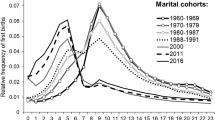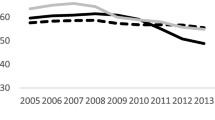Summary
An increase in the number of ex-nuptial births over the last ten years appears to be related to the increase in the number of de facto couples. De facto couples with ex-nuptial births are frequently of lower socio-economic status than couples with nuptial births although they do not differ from married couples in their attitudes to marriage and having children. We argue that uncertain economic circumstances make some couples hesitate to marry; instead they decide to live in de facto relationships in which unplanned pregnancies occur.
Similar content being viewed by others
References
ANDERSON, M. (1985), “Marriage and children in Western Australia, 1842–49”, in P. Grimshaw, C. McConville and E. McEwen (eds), Families in Colonial Australia, George Allen and Unwin, Sydney.
BASAVARAJAPPA, K.G. (1968), “Pre-marital pregnancies and ex-nuptial births in Australia, 1911–66”, Australian and New Zealand Journal of Sociology, 4: 126–145.
CALDWELL, J., CAMPBELL, D., CALDWELL, P., RUZICKA, L., COSFORD, W., PACKER, R., GROCOTT, J. and NEILL, M. (1976), Towards an Understanding of Contemporary Demographic Change, Australian Family Formation Project Monograph No. 4, Department of Demography, The Australian National University, Canberra.
CHOI, C.Y. and RUZICKA, L.T. (1987), “Recent trends in fertility and family formation”, Journal of the Australian Population Association, 4(2): 123–136.
FAHEY, C. (1985), “Bendigo 1881–1901: a demographic portrait of a Victorian provincial town”, in P. Grimshaw, C. McConville and E. McEwen (eds), Families in Colonial Australia, George Allen and Unwin, Sydney: 138–152.
GLEZER, H. (1988), Maternity Leave in Australia: Employee and Employer Experiences. Australian Institute of Family Studies, Melbourne.
GRIMSHAW, P. and FAHEY, C., “Families and community in nineteenth century Castlemaine”, in P. Grimshaw, C. McConville and E. McEwen (eds), Families in Colonial Australia. George Allen and Unwin, Sydney.
HANNERZ, U. (1969), Soulside: Inquiries into Ghetto Culture and Community. Columbia University Press, New York.
HAREWOOD, J. (1987), “Consensual Unions in Latin America (including the West Indies)”, Paper presented at the IUSSP Seminar on Family Demography and Family Life Cycle, Honolulu, Hawaii.
KELLY, W. and CUTRIGHT, P. (1981), “Illegitimacy in Sweden and Australia: 1911–1974”, Comparative Social Research. 4: 219–242.
KHOO, S.E. (1986), Living Together: Young Couples in De Facto Relationships. Australian Institute of Family Studies Working Paper No. 10, Collins Dove, Melbourne.
RODMAN, H. (1971), Lower Class Families: The Culture of Poverty in Negro Trinidad. Oxford University Press, New York.
SARANTAKOS, S. (1984), Living Together in Australia, Longman Cheshire, Melbourne.
VAN DER KAA, D. (1987), “Europe’s Second Demographic Transition”, Population Bulletin, Population Reference Bureau, Washington, D.C.
Author information
Authors and Affiliations
Rights and permissions
About this article
Cite this article
Khoo, SE., McDonald, P. Ex-Nuptial Births and Unmarried Cohabitation in Australia. Journal of Population Research 5, 164–177 (1988). https://doi.org/10.1007/BF03029344
Issue Date:
DOI: https://doi.org/10.1007/BF03029344




